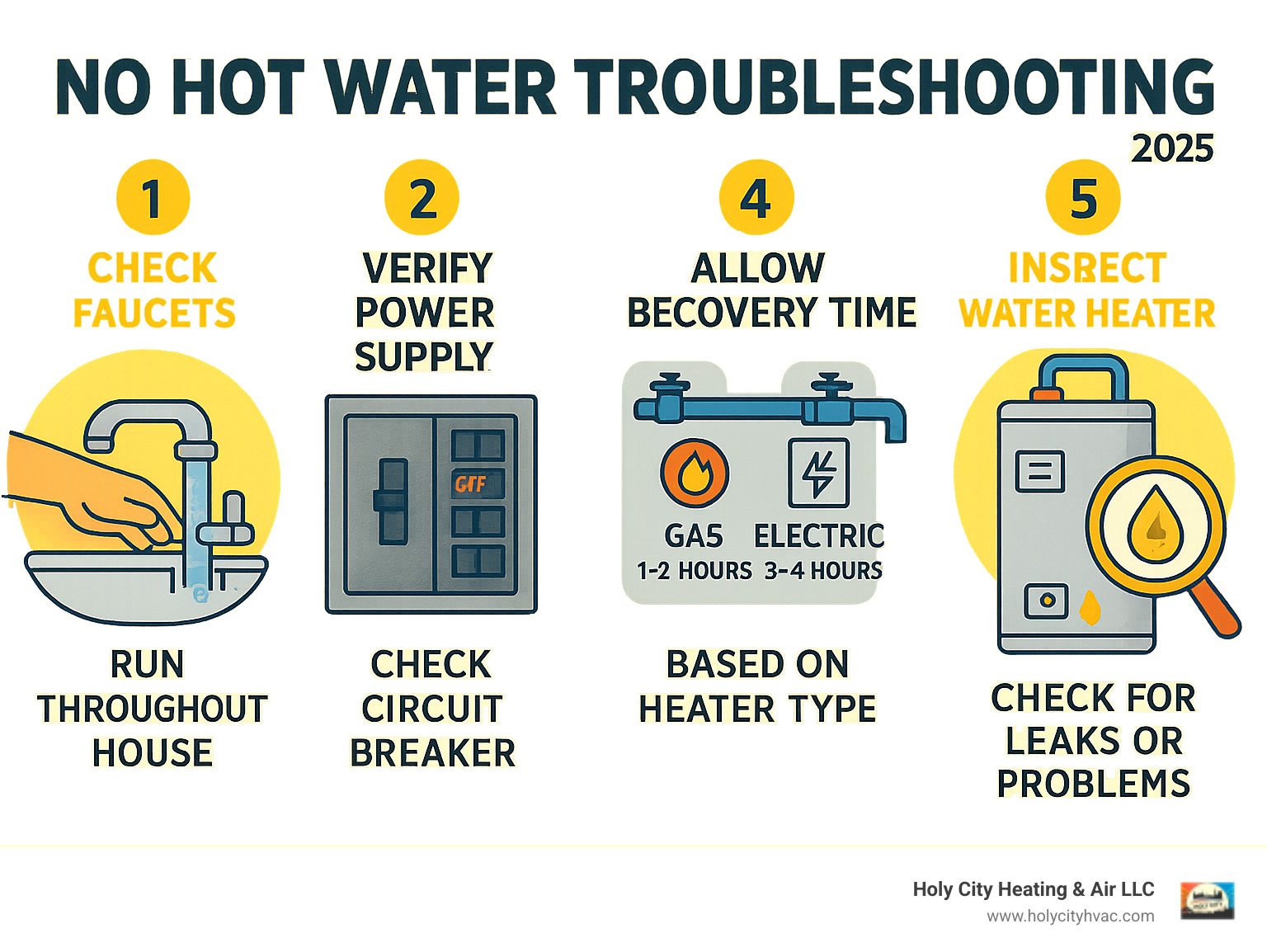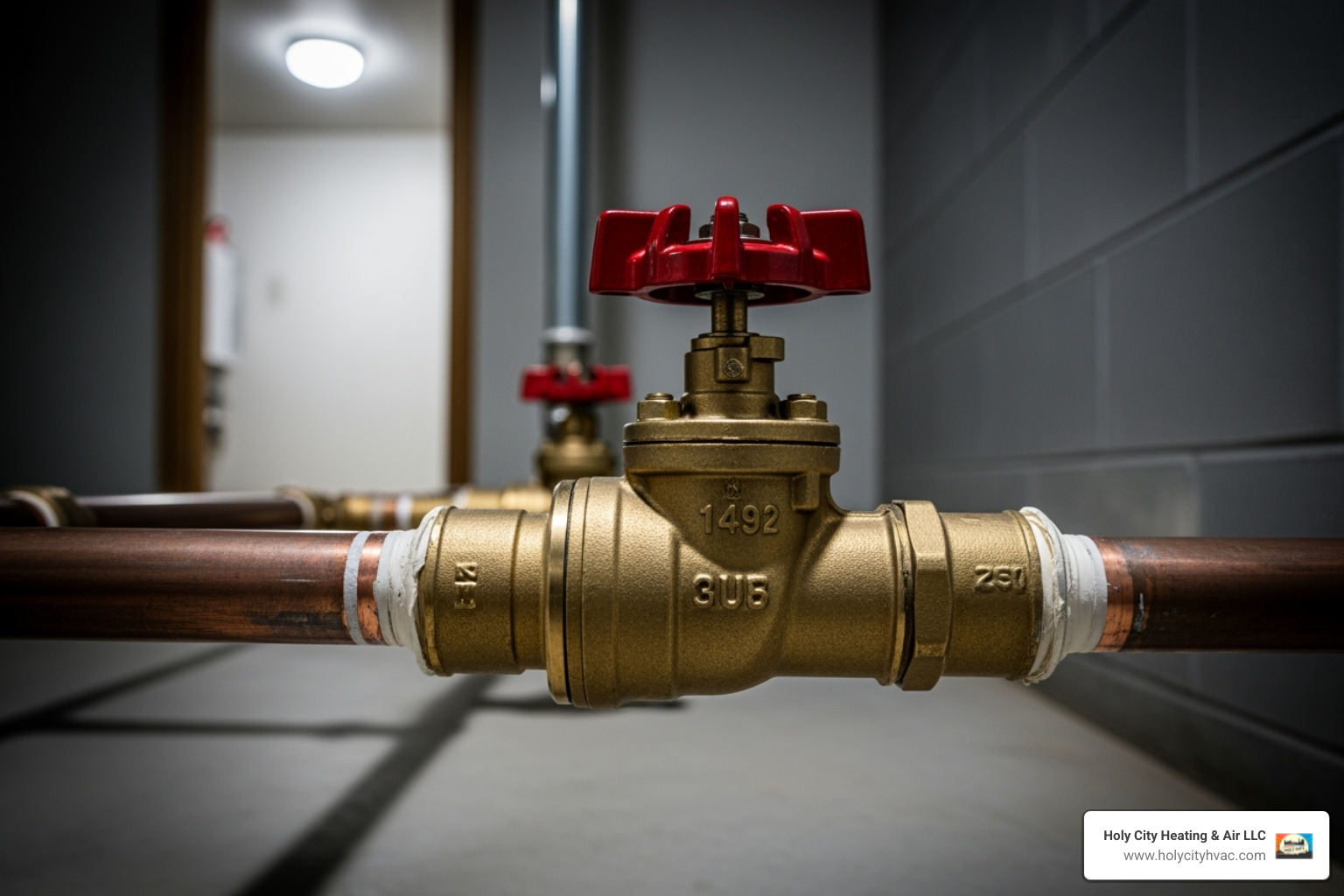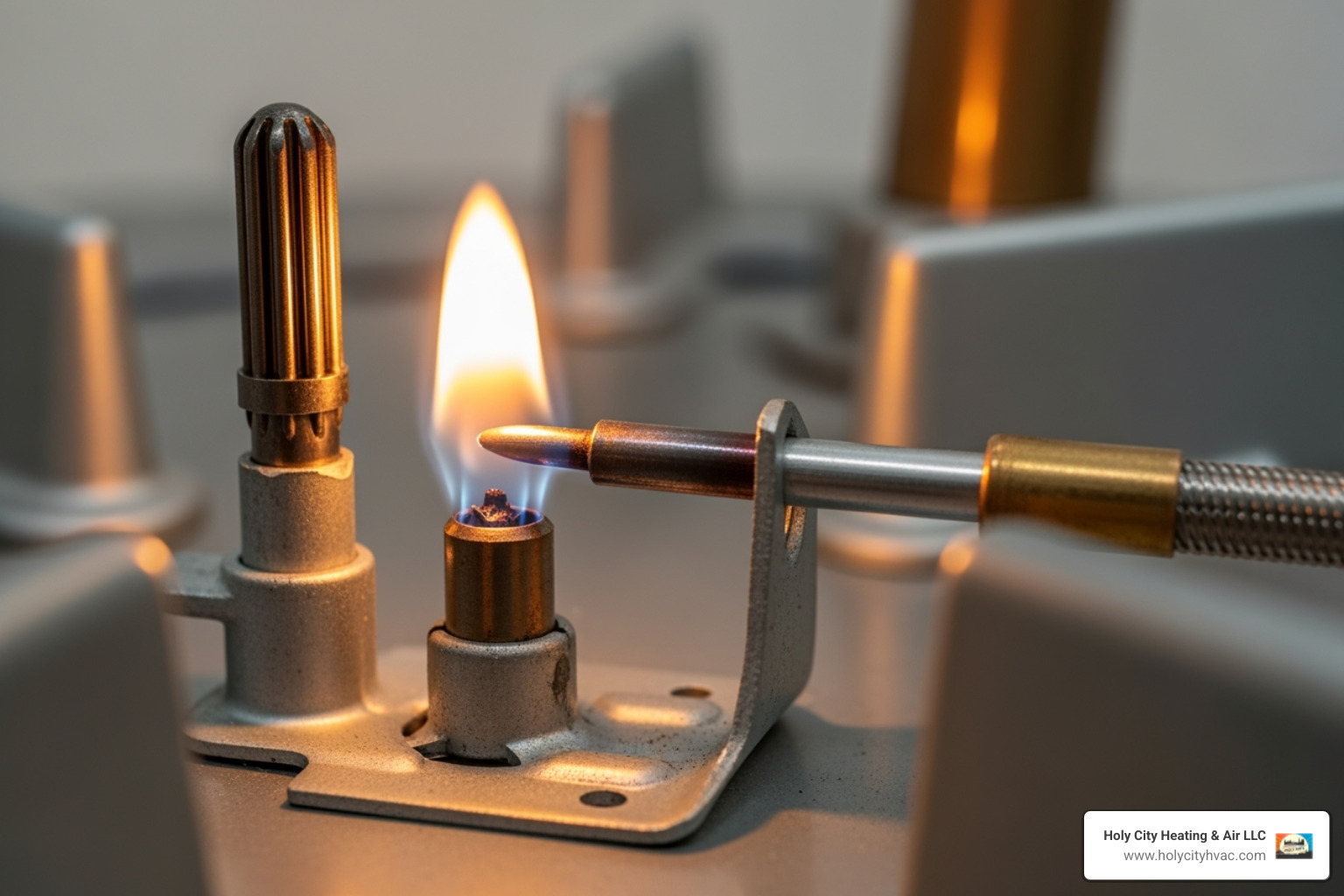
Why Is My Water Cold?
There's nothing more jarring than stepping into the shower, expecting a warm, relaxing stream, only to be hit with a blast of icy water. A sudden lack of hot water is a common household problem, but it can disrupt your entire day, from your morning routine to washing dishes. If you're in the Charleston area and suddenly find yourself with no hot water, don't panic. Many common issues can be diagnosed and even fixed without needing to call a professional right away.
This guide is designed to walk you through the troubleshooting process step-by-step. We'll start with the simplest checks that anyone can do, then move on to more specific issues related to both gas and electric water heaters. Understanding the cause is the first step to finding a solution.
Quick Troubleshooting Checklist for No Hot Water:
- Check All Faucets: Is the problem isolated to one shower or sink, or is it affecting the entire house? This helps determine if the issue is with the fixture or the water heater itself.
- Verify Power or Gas Supply: A tripped breaker or an extinguished pilot light are common culprits. Check your electrical panel and the pilot light on your gas heater.
- Confirm Water Supply: Ensure the cold water inlet valve to your water heater is fully open. Sometimes, it can be accidentally turned off.
- Allow Recovery Time: Has your household used a lot of hot water recently? Dishwashers, laundry, and multiple showers can drain the tank. It may just need time to reheat.
- Inspect Your Water Heater: Look for any obvious signs of trouble, like water pooling around the base, error codes on a digital display, or unusual noises.
Most hot water problems fall into a few common categories. Electric water heaters often face issues with tripped breakers, faulty heating elements, or thermostat malfunctions. Gas water heaters are more prone to problems with the pilot light, thermocouple, or gas supply. It's also worth noting the age of your unit; according to industry data, most tank-style water heaters have a lifespan of about 10-15 years. After that, they become less efficient and more likely to fail. A gas water heater typically recovers in about an hour for a 40-gallon tank, while an electric model can take twice as long.
Whether you're dealing with a completely cold system or just lukewarm water, this guide will help you diagnose the most likely causes and find the right solution. We'll start with the basics and then dive deeper into specific troubleshooting for your type of water heater. For an overview of how water heating works, see water heating.

First Steps: Universal Checks Before You Panic
Before you start worrying about expensive repairs or a full replacement, let's cover the simple checks. Often, the reason for no hot water is a surprisingly easy fix. Think of this as your initial investigation—a few minutes here can save you time, money, and a lot of stress. These are the most common culprits behind a sudden loss of hot water.

Is It a Power or Supply Issue?
First, determine the scope of the problem. Go to each faucet in your house—kitchen, bathrooms, utility sink—and check the hot water. If only one faucet is affected, the issue is likely with that specific fixture, such as a clogged aerator or a faulty cartridge in the handle, not your water heater.
If you have no hot water anywhere in the house, the next step is to check your utilities. A brief power outage, even for a second, can trip a circuit breaker or reset the electronic controls on modern water heaters. While it's obvious that an electric heater needs power, many people don't realize that most modern gas water heaters also require electricity for their ignition systems and safety controls.
Here’s what to check:
- Main Water Valve: This is usually located where the main water line enters your house, often in a basement, crawl space, or utility closet. Make sure the valve is fully open. A lever-style handle should be parallel to the pipe, and a round handle should be turned all the way counter-clockwise.
- Gas Supply Valve (for gas heaters): Find the gas line running to your water heater. There will be a shut-off valve on this line. Like the main water valve, if it has a lever handle, it should be parallel to the pipe to be open. If it's perpendicular, the gas is off.
- Circuit Breaker Panel: Your electric water heater is a high-power appliance and will have its own dedicated circuit breaker, often a large, double-pole breaker. Look for any breakers that are in the 'off' or a middle 'tripped' position. To reset it, flip the breaker firmly to the 'off' position and then back to 'on.' If it trips again immediately, do not reset it again. This indicates a more serious electrical problem that requires a professional electrician or a qualified plumber. For more information on home maintenance, check out our Plumbing Tips for Better Functionality.
Has the Water Heater Had Time to Recover?
Sometimes, the problem isn't a malfunction but simply a matter of demand exceeding supply. If your family has just gone through a series of showers, run the dishwasher, and started a load of laundry, you may have simply used up all the hot water in the tank. Your water heater needs time to heat the new, cold water that has refilled the tank.
This is known as the First-Hour Rating (FHR), which indicates how many gallons of hot water a unit can produce in its first hour of operation. If your household's demand exceeds this rating, you'll run out of hot water.
Water heater recovery time varies significantly by fuel type:
- Electric Water Heaters: These are the marathon runners of water heating. They heat water more slowly but steadily. A typical 40-gallon electric tank can take up to 4 hours to fully reheat from cold. The advantage is that they are generally very good at maintaining the temperature once it's reached.
- Gas Water Heaters: These are the sprinters. A powerful gas burner heats water much faster. A 40-gallon gas tank can often recover in about 2 hours, sometimes even less. This is a major reason why many homeowners in the Charleston area, especially those with larger families, prefer gas models.
If you suspect high usage is the culprit, the solution is simple: wait. Give the unit a couple of hours to catch up. To prevent this in the future, try to space out hot-water-heavy activities. For instance, run the dishwasher overnight and do laundry on a different schedule from when everyone takes their showers. Understanding your family's usage patterns is key. For more on this, see our guide to Hot Water Demand in Johns Island.
Troubleshooting Gas vs. Electric Water Heaters
Once you've ruled out the basic supply and recovery issues, it's time to get specific. The next steps in troubleshooting your no hot water problem depend heavily on whether you have a gas or electric water heater. While both serve the same purpose, their internal workings and common failure points are quite different. Understanding which type you have is the first step to a successful diagnosis.
| Issue Type | Gas Water Heater | Electric Water Heater - Pilot Light Out: The most common issue. The pilot light is a small, continuous flame that ignites the main burner. If it goes out, the water won't heat. You may be able to relight it yourself by following the manufacturer's instructions. | - Tripped Circuit Breaker: Electric heaters draw a lot of power and are usually on a dedicated circuit. Check your home's electrical panel for a tripped breaker. - Faulty Thermocouple: This safety device shuts off the gas if the pilot light goes out. If it's dirty or failing, it won't allow the pilot to stay lit. - Failed Heating Elements: Electric heaters have one or two heating elements. If one fails, you might get lukewarm water instead of no hot water at all. If both fail, you'll get nothing but cold. This often requires a professional replacement. - Faulty Gas Control Valve: This is a more complex component that regulates gas flow. If it fails, the heater won't send gas to be ignited, and you'll have no hot water. This is a job for a professional. | - Faulty Thermostat: The thermostat controls the heating elements. If it's broken, it won't signal the elements to turn on, resulting in no hot water. - Blocked Vent: A blocked flue or vent can cause a safety switch to shut off the unit. This is a serious safety hazard, as it can lead to carbon monoxide buildup. | - High-Temperature Cutoff Switch: This is a safety feature that trips if the water gets too hot. It often has a manual reset button, but if it keeps tripping, it indicates a deeper problem. - Sediment Buildup: Over time, mineral deposits can accumulate at the bottom of the tank, insulating the water from the burner and reducing efficiency. | - Sediment Buildup: Similar to gas heaters, sediment can build up and cover the lower heating element, causing it to burn out prematurely. - Gas Leak: If you smell rotten eggs, leave the house immediately and call your gas company. Do not operate any electrical switches or create any sparks. | - Wiring Issues: Faulty or loose wiring can prevent the heater from getting power. This is a job for a qualified electrician or plumber. -
Diagnosing a Gas Water Heater with No Hot Water

Gas water heaters are generally reliable, but when they fail, the issue often revolves around the pilot light and gas supply. Here’s a more detailed look at what could be wrong:
Check the Pilot Light: The first and most common culprit is an extinguished pilot light. This is a small, continuous flame that ignites the main burner whenever the thermostat calls for heat. If it goes out, the water won't heat. Look for a small access panel near the bottom of your water heater. You should see a small, steady blue flame. If you don't see a flame, the pilot light is out. Most units have relighting instructions printed on a label nearby. Following these instructions carefully is crucial for safety. If you're unsure, it's always best to call a professional. For a general guide, you can review how to relight a pilot light. If the pilot light won't stay lit, the problem is likely the thermocouple.
Inspect the Thermocouple: The thermocouple is a safety device that senses the pilot flame and shuts off the gas supply if the flame goes out, preventing gas from filling your home. It's a thin copper wire that extends from the gas control valve to the pilot light flame. If the thermocouple is faulty, dirty, or has been bent too far from the flame, it will shut off the gas even if the pilot is lit. You can sometimes clean a dirty thermocouple with fine-grit sandpaper, but if it's damaged, it will need to be replaced. This is a relatively inexpensive part, but the replacement can be tricky. If you suspect a gas leak (a smell like rotten eggs), do not attempt any repairs. Leave your home immediately and call your gas company from a safe distance, then contact us for Gas Piping Repair in Charleston,SC.
Faulty Gas Control Valve: This is the brain of your gas water heater, controlling the flow of gas to the burner. If this valve fails, it won't send gas to be ignited, and you'll have no hot water. Diagnosing and replacing a gas control valve is a complex job that should be left to a qualified technician.
Troubleshooting an Electric Water Heater for No Hot Water

Electric water heaters are simpler in design than their gas counterparts, but they have their own unique set of potential issues, almost all of which are electrical in nature.
Check the Circuit Breaker Again: We mentioned this in the initial checks, but it's worth repeating. An electric water heater uses a lot of power and typically has a dedicated double-pole breaker. It's the first thing to check. If it has tripped, reset it once. If it trips again, there's a more serious underlying issue, like a short circuit or a-failing heating element, and you should call a professional immediately.
Press the High-Temperature Cutoff Reset Button: Most electric water heaters have a red reset button located on the unit itself, usually behind a small access panel. This is a safety device that trips if the water temperature gets dangerously high. Sometimes, a power surge or a faulty thermostat can cause it to trip. Turn off the power to the water heater at the circuit breaker first. Then, remove the access panel (you may need a screwdriver) and press the red button firmly. If you hear a click, it has been reset. Restore power and wait to see if the water heats up. If it trips again, it's a sign of a problem with the thermostat or heating element.
Test the Heating Elements: Most electric water heaters have two heating elements, one at the top and one at the bottom. If one fails, you might get lukewarm water instead of no hot water at all. If both fail, you'll get nothing but cold. Testing and replacing these elements requires a multimeter and a good understanding of electrical work. Due to the risk of electric shock, this is a job best left to a professional. If you need help, our team is experienced in Electric Tankless Water Heater Repair in Charleston, SC, and we service all types of electric water heaters.
Check the Thermostats: Like the heating elements, most electric models have two thermostats. If one or both are faulty, they won't signal the heating elements to turn on. Adjusting or replacing a thermostat involves working with electrical wiring and should be handled by a qualified technician to ensure it's done safely and correctly.
Recent posts


















